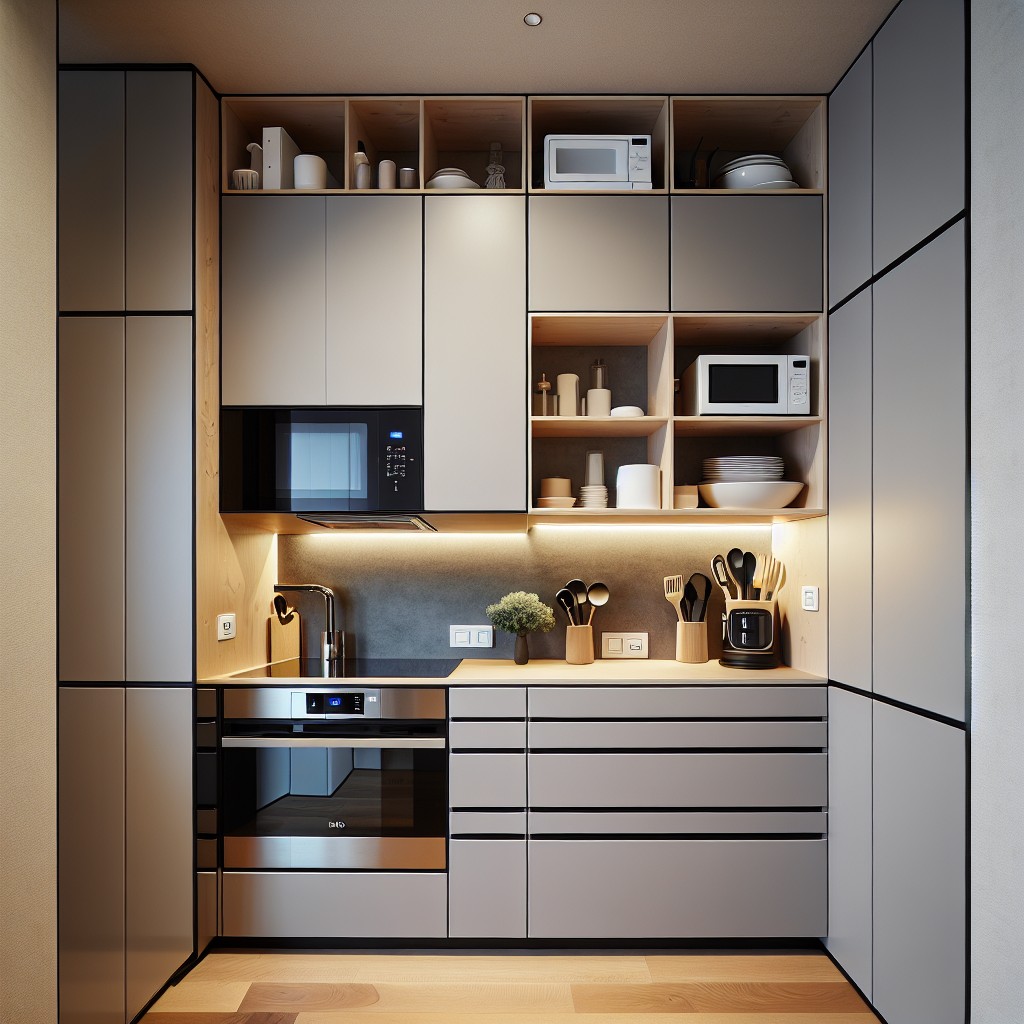Last updated on
This blog post offers practical insights on optimal placement of a microwave in a small kitchen, providing a myriad of spatial-efficient solutions for you to consider.
Key takeaways:
- Mount it on the wall (consider bracket or shelf method)
- Under the counter (ensure clearance, accessibility, ventilation, lighting, custom drawers, stability)
- Above your stove (consider height, compatibility, cabinetry adjustment, professional help)
- On a rolling cart (portability, storage benefits, height advantage, design match, ventilation, stability)
- Electrical considerations (voltage requirements, circuit load, outlet placement, cord length, professional installation)
What's Inside
Mount It On the Wall

When eyeing your wall space for a microwave installation, it’s crucial to consider the bracket or shelf method. Utilizing a wall-mounted bracket provides a secure and space-saving option, freeing up precious counter space.
If opting for a shelf, ensure it’s robust enough to support the microwave’s weight. Positioning is key—install the unit at a height that avoids unnecessary bending or stretching, while keeping it easily accessible for daily use.
Be mindful of surrounding cabinetry, aiming for a spot that doesn’t crowd your workflow or block appliance doors. Remember to leave adequate ventilation space around the unit to prevent overheating.
Under the Counter
When considering an under-the-counter placement, prioritize convenience and functionality. This location is often overlooked, yet it has the potential to save valuable counter space without sacrificing easy access. Here are a few points to keep in mind:
1. Ensure Sufficient Clearance: Check that there’s enough room for the door to swing open, and there’s ample space above for steam and heat to dissipate safely.
2. Accessibility: Position the unit so that you can easily view and reach the controls without bending down too much. This is particularly important for ease of use and to prevent any strain.
3. Ventilation: Microwave vents should not be obstructed. Confirm that there’s adequate airflow, and if your chosen model vents from the bottom, an under-the-counter placement might not be suitable.
4. Lighting: With the microwave installed under the counter, ensure that the area is well-lit, possibly by installing additional lighting, so you can safely handle hot food and see the controls clearly.
5. Custom Drawers: Some manufacturers offer microwave drawer units that can be built right into the cabinetry, which could be an elegant and functional solution.
6. Stability: Be certain that the shelf or cabinet can support the weight of the microwave. Reinforcement may be necessary to ensure it’s securely anchored.
Always consult the microwave’s installation manual for specific instructions and safety guidelines, and when in doubt, consider hiring a professional to ensure a safe and proper installation.
Above Your Stove
Harnessing vertical space is a savvy move in a snug kitchen. Installing an over-the-range microwave not only smartly capitalizes on this area but also merges two crucial kitchen functions. It saves precious counter space and circumvents the necessity for a separate range hood, as these microwaves come equipped with built-in venting systems.
Before you head down this path, consider the height aspect. An ideal placement allows the controls to be conveniently accessible, with the microwave’s bottom at least 13 to 18 inches above the range top to ensure comfortable access and safety from rising heat.
Additionally, pay attention to the microwave’s width, it should align with the stove for a cohesive look. Compatibility with the existing cabinetry is paramount, as you might need to tweak the cabinetry to nestle the appliance effortlessly in place. Lastly, since installation might involve electrical and ventilation adjustments, enlisting professional help ensures a secure and efficient setup.
On a Rolling Cart
A rolling cart offers a flexible solution for your microwave placement woes in a small kitchen. Here are some points to keep in mind:
- Portability: Easily move it aside when you need more space, an ideal feature for tiny kitchens where every inch counts.
- Storage Benefits: Many carts come with additional shelves and drawers, which can be a boon for stowing away kitchen tools, thus freeing up valuable counter space.
- Height Advantage: Unlike fixed spots, you can choose a cart that places your microwave at a convenient height, reducing the need to stoop or reach up.
- Design Match: Select a cart that complements your kitchen decor for an integrated look, with materials ranging from sleek metal to classic wood.
- Ventilation: Ensure the cart doesn’t encase the microwave, as adequate airflow is crucial for appliance longevity.
- Stability: When the microwave is in use, the cart needs to be steady. A model with a locking mechanism prevents rolling and enhances safety.
Utilizing a rolling cart is a smart and stylish way to incorporate a microwave into a small kitchen, without compromising on the functionality or aesthetic of the space.
Electrical Considerations for Installing a Microwave
Ensuring the safety and efficiency of your microwave is paramount, which is why considering the electrical aspects of installation is a critical step.
- Voltage Requirements: Microwaves typically run on a standard 120-volt outlet, so confirm that you have the right type of outlet where you plan to place the appliance.
- Circuit Load: Microwaves draw a substantial amount of power. It’s advisable to have it on a dedicated circuit to prevent tripping the breaker, especially in a small kitchen where multiple appliances might be used simultaneously.
- Outlet Placement: Ideally, the outlet should be close to where the microwave is to be located to avoid the use of extension cords, which can be a fire hazard.
- Cord Length: Check the length of the microwave’s power cord before mounting or placement to make sure it can easily reach the outlet without stretching.
- Professional Installation: If you’re considering a location that requires new wiring, such as a microwave-over-range (MOR) setup, hiring a licensed electrician is recommended for safe and up-to-code installation.




